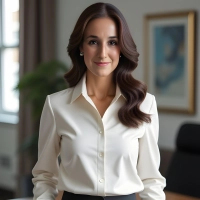Developing Succession Plans and Mentoring Future Leaders: 4 Key Steps
In today's rapidly evolving business landscape, developing strong leadership succession plans is crucial for long-term success. This article explores key steps in cultivating future leaders, drawing on insights from industry experts. From building leadership capacity to creating data-driven succession strategies, discover how organizations can effectively prepare for tomorrow's challenges.
- Build Leadership Capacity Through Strategic Development
- Multiply Vision by Cultivating Internal Talent
- Prepare Future Leaders with Personalized Growth Plans
- Create Data-Driven Succession with Leadership Scorecards
Build Leadership Capacity Through Strategic Development
I recently collaborated with a CEO who recognized the need to build leadership capacity within their growing organization. The key steps we took began with identifying critical roles and the core competencies required for success in those positions, both now and in the future. This involved analyzing the company's strategic goals and anticipating future leadership needs.
Next, we assessed the existing talent pool to identify high-potential individuals who demonstrated the aptitude and interest in taking on greater responsibility. This assessment wasn't solely based on current performance but also on their learning agility and leadership potential. Following this assessment, we worked with the CEO and senior leaders to develop individualized development plans for these emerging leaders. These plans often included targeted training, mentorship opportunities with experienced leaders within the organization, cross-functional projects to broaden their understanding of the business, and increased levels of responsibility over time. We also established a formal mentoring program, pairing senior leaders with high-potential individuals to provide guidance, share insights, and foster their growth. The process emphasized creating a culture of continuous development and ensuring a smooth transition of leadership as the organization evolved.

Multiply Vision by Cultivating Internal Talent
One example is when I worked with a founder who was scaling quickly but had no clear leadership pipeline in place. She was doing everything herself—sales, client management, operations—and knew she needed to step back to focus on growth, but she didn't trust that anyone could fully replace her in key areas.
The first step was mapping the business functions—identifying not just the tasks she performed but also the thinking and decision-making frameworks she used behind them. We built a simple leadership competency model based on real needs: strategic thinking, client relationship management, operational execution, and brand stewardship.
Next, we identified high-potential team members who already showed ownership and strategic instincts. Instead of immediately promoting them, we designed mentorship projects—small but meaningful leadership opportunities like owning a campaign, managing a client relationship, or optimizing a system—with check-ins for feedback and coaching along the way.
Finally, we created a succession plan in which leadership development was tied to outcomes, not just time served, making it clear what skills and results were needed to step into bigger roles.
The result? Within a year, two team members had grown into leadership positions, client satisfaction remained high, and the founder finally had the freedom to step into a true CEO role.
The biggest lesson: Succession planning isn't about replacing yourself—it's about multiplying your vision through others.

Prepare Future Leaders with Personalized Growth Plans
There was a time when I helped a senior leader develop a succession plan and mentor emerging leaders. We began by identifying potential successors through performance reviews and 360-degree feedback. Once we had a list, we focused on personalized development plans, including leadership training, job rotations, and shadowing opportunities to provide hands-on experience.
Mentorship was a significant part of the process. We paired potential leaders with seasoned executives who could offer guidance, share experiences, and provide feedback. This not only accelerated their learning but also prepared them for future challenges. Regular check-ins and progress assessments were essential, allowing us to make adjustments as needed and ensure alignment with organizational goals.
The key steps were identifying potential successors, creating personalized development plans, implementing mentorship programs, providing hands-on experience, and conducting regular assessments. This approach prepared the next generation of leaders and fostered a culture of continuous learning and development within the organization.

Create Data-Driven Succession with Leadership Scorecards
We helped one client scale their succession planning by creating a 'leadership readiness scorecard' — a matrix evaluating skills like decision-making, emotional intelligence, conflict resolution, and business literacy. Every quarter, potential successors self-assessed and received 360-degree feedback from peers and supervisors. This data-driven approach depersonalized succession, focused development conversations, and ensured promotions were readiness-based, not politics-based. As a result, leadership transition timelines dropped by 40%, and internal promotion rates tripled in two years.


